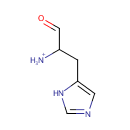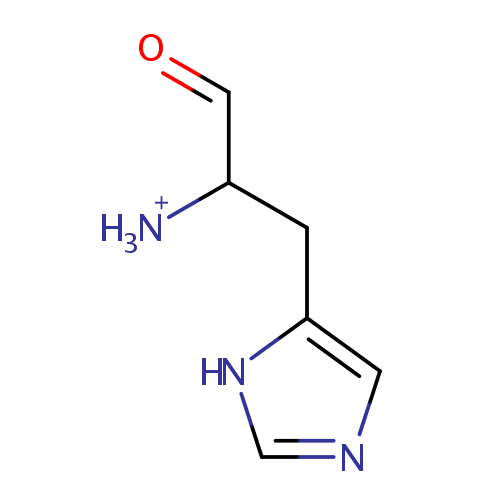|
Record Information |
|---|
| Version |
1.0 |
|---|
| Update Date |
1/22/2018 11:54:54 AM |
|---|
|
Metabolite ID | PAMDB001944 |
|---|
|
Identification |
|---|
| Name: |
L-Histidinal |
|---|
| Description: | L-histidinal is a member of the chemical class known as Imidazoles. These are compounds containing an imidazole ring, which is an aromatic five-member ring with two nitrogen atoms at positions 1 and 3, and three carbon atoms. L-histidinal is invovled in Biosynthesis of secondary metabolites, and Histidine metabolism. (KEGG) |
|---|
|
Structure |
|
|---|
| Synonyms: | |
|---|
|
Chemical Formula: |
C6H10N3O |
|---|
| Average Molecular Weight: |
140.1631 |
|---|
| Monoisotopic Molecular
Weight: |
140.082386957 |
|---|
| InChI Key: |
VYOIELONWKIZJS-UHFFFAOYSA-O |
|---|
| InChI: | InChI=1S/C6H9N3O/c7-5(3-10)1-6-2-8-4-9-6/h2-5H,1,7H2,(H,8,9)/p+1 |
|---|
| CAS
number: |
Not Available |
|---|
| IUPAC Name: | 1-(1H-imidazol-5-yl)-3-oxopropan-2-aminium |
|---|
|
Traditional IUPAC Name: |
1-(3H-imidazol-4-yl)-3-oxopropan-2-aminium |
|---|
| SMILES: | [NH3+]C(CC1=CN=CN1)C=O |
|---|
|
Chemical Taxonomy |
|---|
|
Taxonomy Description | This compound belongs to the class of organic compounds known as aralkylamines. These are alkylamines in which the alkyl group is substituted at one carbon atom by an aromatic hydrocarbyl group. |
|---|
|
Kingdom |
Organic compounds |
|---|
| Super Class | Organonitrogen compounds |
|---|
|
Class |
Amines |
|---|
| Sub Class | Aralkylamines |
|---|
|
Direct Parent |
Aralkylamines |
|---|
| Alternative Parents |
|
|---|
| Substituents |
- Aralkylamine
- Heteroaromatic compound
- Quaternary ammonium salt
- Imidazole
- Azole
- Azacycle
- Organoheterocyclic compound
- Hydrocarbon derivative
- Organooxygen compound
- Carbonyl group
- Aldehyde
- Organic cation
- Aromatic heteromonocyclic compound
|
|---|
| Molecular Framework |
Aromatic heteromonocyclic compounds |
|---|
| External Descriptors |
Not Available |
|---|
|
Physical Properties |
|---|
| State: |
Not Available |
|---|
| Charge: | 1 |
|---|
|
Melting point: |
Not Available |
|---|
| Experimental Properties: |
|
|---|
| Predicted Properties |
|
|---|
|
Biological Properties |
|---|
| Cellular Locations: |
Cytoplasm |
|---|
| Reactions: | |
|---|
|
Pathways: |
Not Available |
|---|
|
Spectra |
|---|
| Spectra: |
|
|---|
|
References |
|---|
| References: |
- Winder, C. L., Dunn, W. B., Schuler, S., Broadhurst, D., Jarvis, R., Stephens, G. M., Goodacre, R. (2008). "Global metabolic profiling of Escherichia coli cultures: an evaluation of methods for quenching and extraction of intracellular metabolites." Anal Chem 80:2939-2948. Pubmed: 18331064
|
|---|
| Synthesis Reference: |
Not Available |
|---|
| Material Safety Data Sheet (MSDS) |
Not Available |
|---|
|
Links |
|---|
| External Links: |
| Resource | Link |
|---|
| CHEBI ID | Not Available | | HMDB ID | Not Available | | Pubchem Compound ID | 25244065 | | Kegg ID | C01929 | | ChemSpider ID | 3824841 | | Wikipedia ID | Not Available | | BioCyc ID | Not Available |
|
|---|


